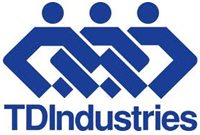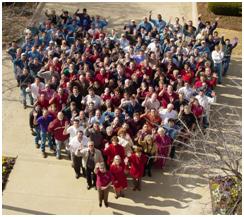AND … How Systems Thinking “Creates” Time for the Proactive Servant Leader
 Our last Servant Leadership Learning Community session of the year was a powerful and eye-opening session. Just being inside TD brings fresh energy as you see a wall of distinguished faces of Partners who have retired and are counting on current TD Partners to keep growing the company. This meeting left us inspired and energized but also reminded us that on the journey of servant leadership, you never reach the finish line. It is truly a journey packed with ups and downs on which, even companies with long-established high-trust cultures of servant leadership experience significant challenges.
Our last Servant Leadership Learning Community session of the year was a powerful and eye-opening session. Just being inside TD brings fresh energy as you see a wall of distinguished faces of Partners who have retired and are counting on current TD Partners to keep growing the company. This meeting left us inspired and energized but also reminded us that on the journey of servant leadership, you never reach the finish line. It is truly a journey packed with ups and downs on which, even companies with long-established high-trust cultures of servant leadership experience significant challenges.
We were grateful to be welcomed back by TDIndustries, our gracious hosts for this October session. TD has maintained a remarkable, pace-setting culture of servant leadership over the last four-plus decades. They have been a “Great Place to Work” for 16 consecutive years and have been a Charter member & co-sponsor of our SLLC organization since day one, 13 years ago. Yet, despite their numerous accomplishments, they will be the first to tell you, they still struggle and encounter daily challenges when it comes to servant leadership. Many of our SLLC members commented at the close how reassuring it was to learn that “even in TD who has earned so many prestigious honors for their culture and business success there are still barriers to overcome.” One of our collective take-aways was to remember the danger of complacency.
Maureen “Mo” Underwood, EVP of People, demonstrated courage and vulnerability by openly sharing many of the findings from TD’s recent GPTW Employee Survey. Out of respect for the confidential nature of the information shared, we cannot share the PowerPoint presentation from TD; however, below is a brief summary of their general findings for your use.
 TDIndustries was founded in 1946 and has grown into one of America’s premier mechanical construction and facility service companies.
TDIndustries was founded in 1946 and has grown into one of America’s premier mechanical construction and facility service companies.
TD is one of only 13 companies to be on FORTUNE Magazine’s 100 Best Places to Work in America list every year since it was created in 1998.
What does it take to be a Great Place to Work?
– Any workplace can be measured through five dimensions: credibility, respect, and fairness (which are attributes of trust), as well as pride and camaraderie. Categories which drive employee engagement.
– The more frequently people meet with their managers to discuss their performance, the more likely they are to trust that senior management has a clear vision and strategy.
– As people meet more regularly with their managers to discuss their performance, their workplace experiences become increasingly more positive.
– Data suggest that managers play a key role in helping people feel like their daily work makes a difference to the organization as a whole.
– Major commitment led by CEO, Harold MacDowell, asking all Supervisors to join him in committing to engage in two performance conversations per month with each Partner they supervise. Four conversations a year will be documented.
– Supervisors are surveyed every year by all their direct reports for improvements and accountability.
Questions for Dialogue from Mo
– Brainstorm the barriers to your company becoming a Great Place to Work.
– Brainstorm solutions to those barriers.
Moving from TD’s Case Study to Discovering Patterns through Systems Thinking
Ann McGee-Cooper then linked Mo’s insightful observations and TD’s strategic response to skills tracing our actions as leaders that result in vicious cycles. Together we found personal entry points to change these discouraging vicious cycles in to virtuous cycles. (Power Point attached). At tables we explored some of these questions to take system’s thinking and apply to a current area of frustration, low trust and/or underperforming teams and search for our own Personal Entry Point.
Our task now is to take what we’ve learned in this session and throughout the year, back to our teams and continue to be mindful of systems thinking in our day-to-day work.
“The servant views any problem in the world as in here, inside oneself, not out there. And if a flaw in the world is to be remedied, to the servant the process of change starts in here, in the servant, not out there.”
– Robert K. Greenleaf
“What am I doing or not doing to contribute to the problem I want to solve.”

 "Ann's influence on our organization was a critical element in our being recognized as one of the 100 Best Companies to Work For in America."
"Ann's influence on our organization was a critical element in our being recognized as one of the 100 Best Companies to Work For in America."